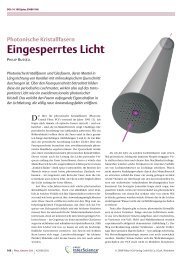Diploma thesis
Diploma thesis
Diploma thesis
Create successful ePaper yourself
Turn your PDF publications into a flip-book with our unique Google optimized e-Paper software.
kcounts / second<br />
0.14<br />
0.12<br />
0.1<br />
0.08<br />
0.06<br />
0.04<br />
0.02<br />
Figure 4.3: Dark counts measurement setup<br />
Gating width: 2.5 ns Detector efficiency 25%<br />
Deadtime: 0 µs<br />
Deadtime: 1 µs<br />
Deadtime: 2 µs<br />
Deadtime: 5 µs<br />
Deadtime: 10 µs<br />
0<br />
0 0.2 0.4 0.6 0.8 1 1.2 1.4 1.6 1.8 2<br />
trigger frequency [MHz]<br />
Figure 4.4: Dark counts, 2.5 ns gating<br />
kcounts / second<br />
4<br />
3.5<br />
3<br />
2.5<br />
2<br />
1.5<br />
1<br />
0.5<br />
Gating width: 5 ns Detector efficiency 25%<br />
Deadtime: 0 µs<br />
Deadtime: 1 µs<br />
Deadtime: 2 µs<br />
Deadtime: 5 µs<br />
Deadtime: 10 µs<br />
0<br />
0 0.2 0.4 0.6 0.8 1 1.2 1.4 1.6 1.8 2<br />
trigger frequency [MHz]<br />
Figure 4.5: Dark counts, 5 ns gating<br />
density filter to simulate single photon sources. After the attenuation their light was<br />
coupled into the detectors (see setup in Figure 4.6).<br />
In this experiment incoming photons constantly hit the detector material. Therefore,<br />
the trigger rate should be related to the count rate linearly. Any nonlinear<br />
increase can be traced back to afterpulsing events. The measurement data plotted<br />
in Figure 4.7 and 4.8 (all data in Appendix A.3.2 and A.3.3) shows that these assumption<br />
is only valid in the case of low trigger rates. For trigger rates above 1<br />
MHz, an additional deadtime is needed to restore the linear increase and discard<br />
afterpulsing effects. This is very apparent in Figure 4.8. The count rate for no<br />
applied deadtime (red graph) increases in a nonlinear manner above 1MHz. The<br />
blue graph (1µs deadtime) exhibits a sharp drop at exactly 1 MHz trigger rate.<br />
The reason for this behaviour is the deadtime of 1 µs. After each avalanche, the<br />
deadtime overwrites the following gating pulse. After each detection the following<br />
gating and hence the following possibility to detect an incoming photon is lost. As<br />
a result, the effective detection efficiency of the APDs decreases. In this extended<br />
43



